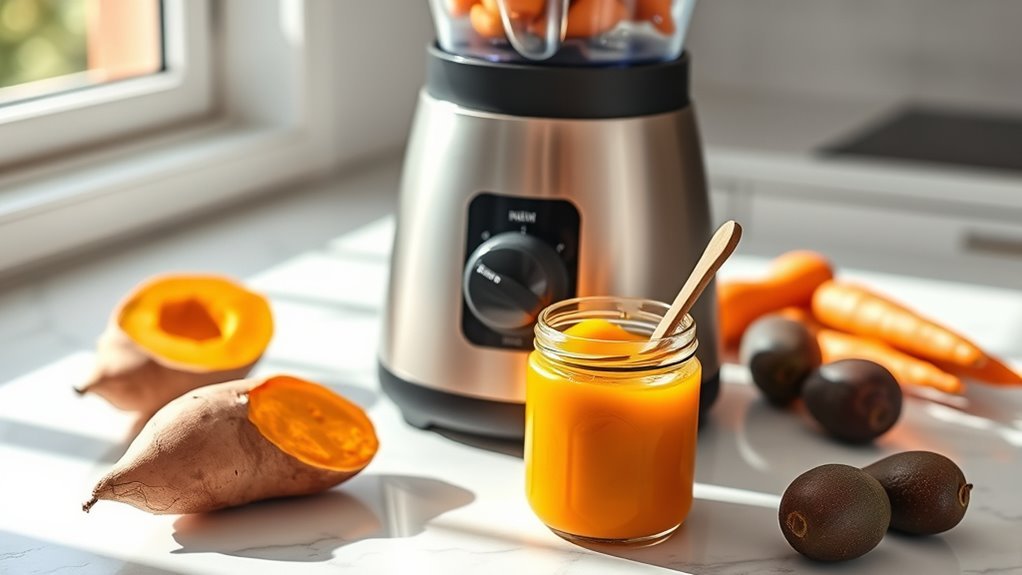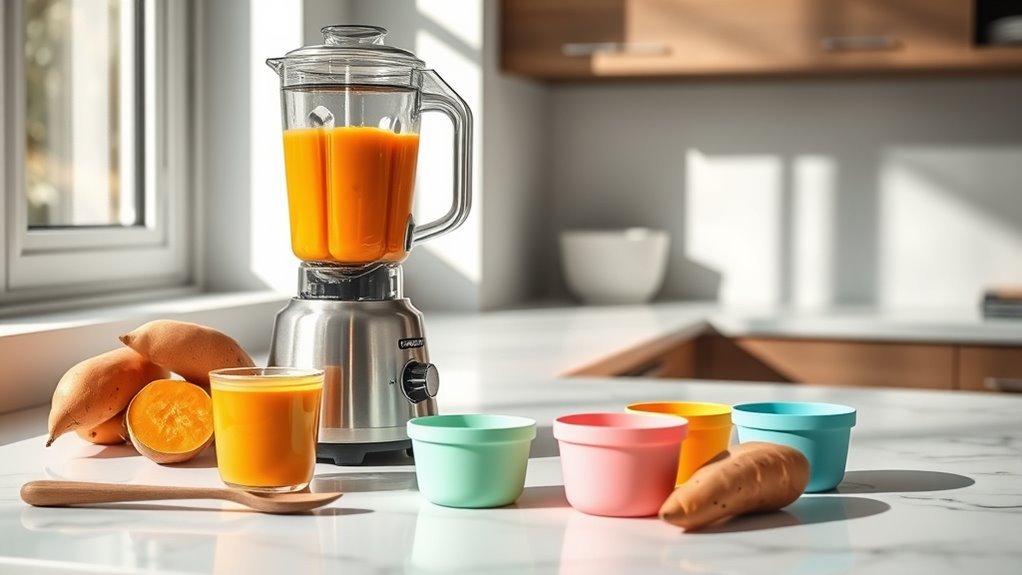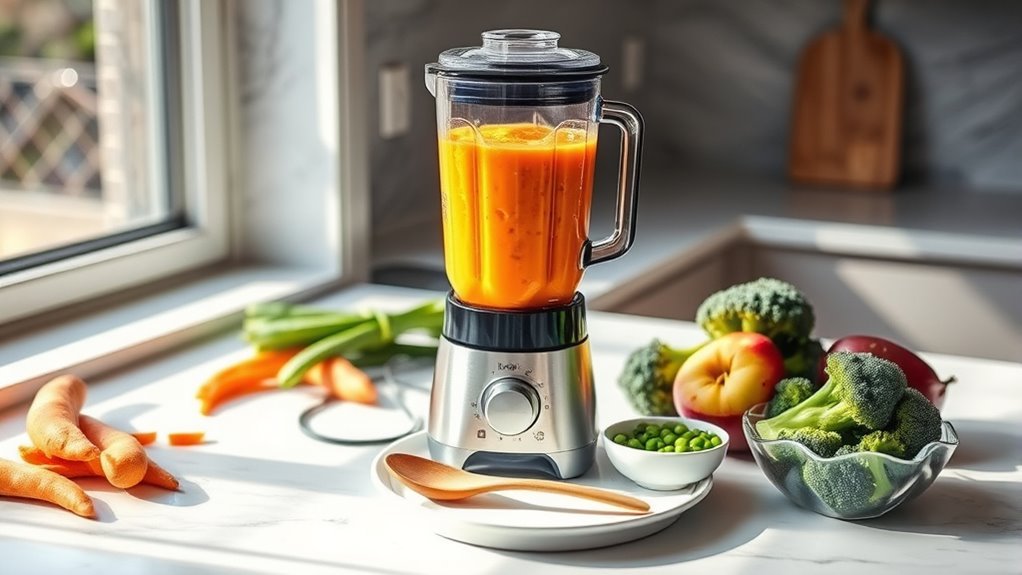Like David against Goliath, we’re taking on the baby food industry with our own kitchen arsenal. Let’s face it—commercial jars are convenient but homemade purees? Superior nutrition, better taste, zero preservatives. We’ve tested dozens of blenders and found some clear winners. The Ninja Professional crushes carrots to silk while the Vitamix actually kills pathogens with heat. Some models even grow with your kid from first bites to family dinners. Want to know which ones won’t break the bank but still deliver the goods?
Why Dedicated Blenders Make Better Baby Food

Why settle for dedicated baby food makers when regular blenders do the job better?
High-powered blenders like the Ninja Professional Plus crush it with 1,200 watts, creating silky-smooth purées without those annoying chunks or fibers.
No baby wants stringy vegetables. Trust us.
We’ve seen the tests.
Dedicated blenders actually cook while they blend.
The Vitamix 5200 hits 165°F in under six minutes—bye-bye, pathogens!
Plus, these stainless steel workhorses are built to last.
The Cuisinart Hurricane Pro weighs 11 pounds. It’s not going anywhere.
Value matters.
The Ninja TWISTi costs about $100 and outperforms those flimsy baby food gadgets.
With proper care techniques, these high-performance blenders can last over a decade, making them a smart investment for growing families.
Seriously, why buy something that’ll break?
Get versatility instead—one durable device that handles everything from fruits to proteins. Easy to use, easy to clean.
Top-Rated Blenders for Creating Smooth Baby Purees
The best blenders for baby purees don’t mess around with performance. We’ve tested the top contenders, and wow—these machines deliver serious results.
The Ninja Professional Plus crushes the competition with its 1,200-watt motor, creating chunk-free homemade baby food every time.
Looking for premium? Vitamix 5200 heats ingredients to 165°F while blending—talk about efficient.
The Baby Brezza One Step handles steaming and blending in 10-15 minutes, perfect for busy parents. Its steel blades cut through tough fruits and vegetables like nobody’s business.
BEABA Babycook offers a massive 5.5-cup capacity with automatic shut-off. Easy to clean, too.
For raw power, Ninja TWISTi‘s 1,600 watts demolishes raw veggies without a trace of chunks. These blenders for making baby purees aren’t playing around.
High-performance blenders create more nutrient-rich baby food by breaking down ingredients more effectively than regular models.
Multi-Functional Options That Grow With Your Child

When investing in kitchen equipment for your little one, multi-functional blenders deliver serious bang for your buck.
Let’s be real – babies don’t stay babies forever.
The BEABA Babycook Neo Baby Food maker shifts perfectly from silky purees to chunky textures with its 5.5-cup capacity.
Genius.
Meanwhile, the Nutribullet Baby steam + blend handles everything in one bowl.
No fuss, simple to use, easy cleaning.
Baby Brezza One Step Baby Food maker’s glass bowl design is perfect for health-conscious parents.
It steams and blends in one – because who’s time for multiple appliances?
The Ninja Foodi goes beyond basic baby food, eventually making family smoothies and even dough.
Trust us, your tiny human will eventually eat real food, and these machines grow right alongside them.
Key Features to Consider When Choosing a Baby Food Blender
How exactly do you separate the truly useful baby food blenders from the gimmicky junk?
Look at power ratings first. Seriously. You’ll need 150-1200 watts to tackle solid foods properly—the Ninja Foodi’s 1200 watts isn’t overkill, it’s necessary.
Capacity matters too. A tiny blender bowl won’t cut it for batch cooking. Find one between 3.5 cups and 72 ounces.
Don’t overlook the blend cycle options. Variable speeds like BEABA’s let you control texture precisely.
And cleaning? No parent needs that headache. Dishwasher-safe plastic parts are non-negotiable.
Consider your counter space—the BEABA’s 14×12.3×11-inch footprint won’t dominate your kitchen.
Bonus points for units with food storage options, like a cup with lid for on-the-go feeding.
Multi-function blenders save time—steam and blend in one? Yes please.
Budget-Friendly Blenders That Don’t Sacrifice Quality

Finding budget-friendly blenders doesn’t mean you’re stuck with mediocre baby food. We’ve tested several small appliance options that deliver smooth purees without emptying your wallet. Seriously.
The Nuby Mighty Blender Baby Food Maker stands out with its 22-piece system for under $50. Easy cleaning. Simple operation. Makes baby food at home without the fuss.
| Model | Price | Power | Why We Love It |
|---|---|---|---|
| Ninja TWISTi | Lowest on list | 1,600 watts | Smooth purees, period. |
| Sage Spoonfuls | Budget pick | 300 watts | Dishwasher-safe parts |
| Nuby Mighty Blender | Under $50 | Not specified | Complete 22-piece system |
Each of these food processors scored well in our lab tests. No chunks. No nonsense. Just quality baby food makers that won’t break the bank. Budget-friendly doesn’t have to mean baby gets second best.
Frequently Asked Questions
What Is the Best Blender for Baby Food Puree?
Did you know 70% of parents overspend on baby gear? We’d recommend the Vitamix 5200, with 1,200-watt power, exceptional blade sharpness, and precise texture control. It leads brand rankings with outstanding warranty coverage.
Can You Use a Blender to Puree Baby Food?
Yes, we’ve found blenders are excellent for baby food puree! They offer texture control for vegetable blending and fruit mixtures while maintaining nutritional value. Remember safety in ingredient prep, storage tips, and thorough cleaning advice to prevent baby allergies.
What Is the Best Thing to Puree Baby Food In?
We’d recommend a food processor or specialized baby food maker. Though food mills, sieves, fork mashing, and hand crushers work well too. A pestle mortar, bean grinder or potato ricer offers manual alternatives for different textures.
What Purees Better, Blender or Food Processor?
Lab tests show 1,200-watt blenders create smoother purees than food processors. We’ve found blenders consistently outperform processors in texture comparison and blade efficiency when making baby food—they’re simply better at eliminating chunks.

